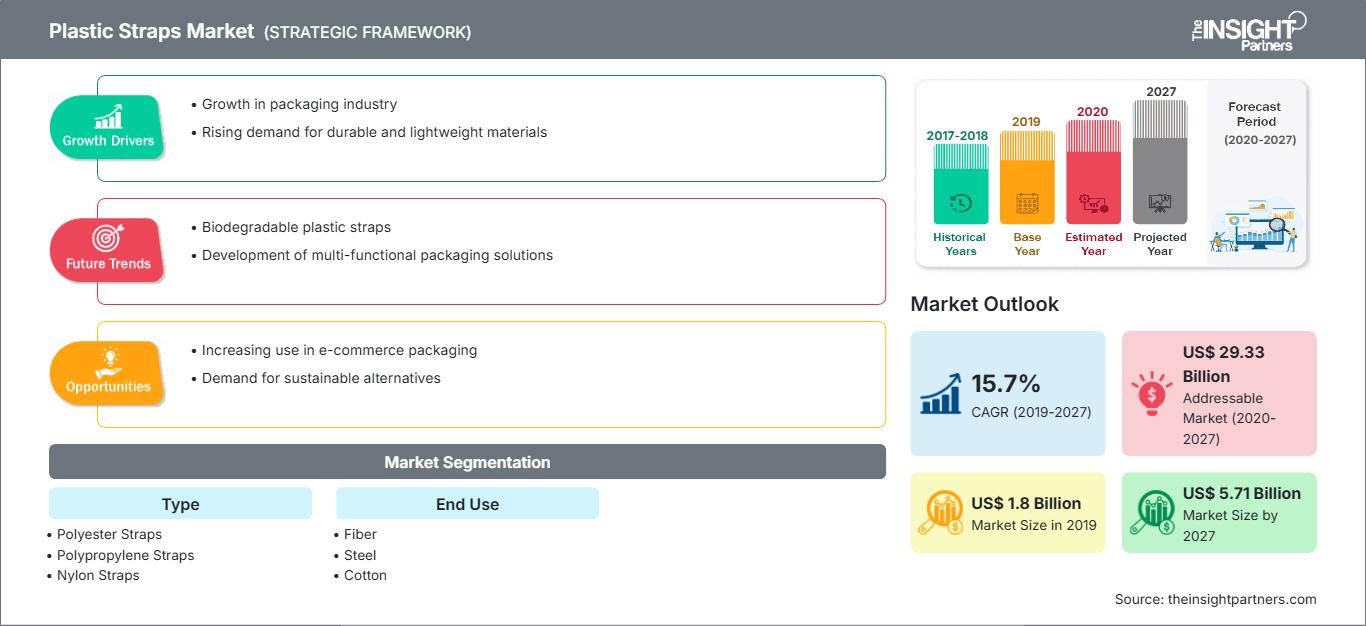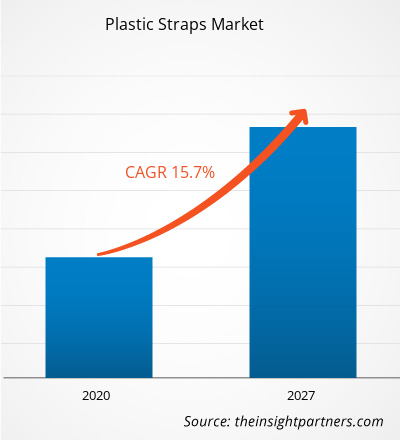[Forschungsbericht]Der Markt für Kunststoffbänder wurde 2019 auf 1.802,47 Millionen US-Dollar geschätzt und soll bis 2027 voraussichtlich 5.714,12 Millionen US-Dollar erreichen; von 2020 bis 2027 wird ein durchschnittliches jährliches Wachstum von 15,7 % erwartet.
Die Nachfrage nach Kunststoffbändern steigt aufgrund der weltweit stark steigenden Nachfrage nach besseren Verpackungs- und Logistiklösungen. Darüber hinaus bietet der Aufschwung in der Papier- und Bauindustrie Wachstumschancen für den Markt für Kunststoffbänder. Das Wachstum des Marktes für Kunststoffbänder wird zusätzlich durch die zunehmende Verwendung von Kunststoffbändern in der Papier-, Stahl- und Ziegelindustrie vorangetrieben. Kunststoffbänder werden aus Polypropylen und Polyester hergestellt und sind in einer Vielzahl von Stilen, Stärken und Ausführungen erhältlich.
Nordamerika hat den größten Anteil am globalen Markt für Kunststoffbänder. Der größte Marktanteil der Region Nordamerika ist hauptsächlich auf den Anstieg der Produktion und des Verbrauchs von Kunststoffbändern in den entwickelten und sich entwickelnden Volkswirtschaften Nordamerikas zurückzuführen. Die USA gelten als einer der größten Märkte mit einer sehr hohen Nachfrage und Produktion von Kunststoffbändern. Zu den anderen Volkswirtschaften, die dem Wachstumsmuster des Marktes für Kunststoffbänder folgen, gehören Kanada und Mexiko. Die Region Nordamerika trägt erheblich zum Wachstum des Marktes für Kunststoffbänder bei, aufgrund von Faktoren wie der schnellen Urbanisierung sowie der zunehmenden Neigung zu besserer Logistik und fortschrittlicheren Produkten der Verpackungsindustrie, unterstützt durch einen Anstieg des verfügbaren Einkommens. Abgesehen davon ist es die Präsenz großer Hersteller in der Region, die das Wachstum des Marktes für Kunststoffbänder in der Region erheblich vorantreibt.
Die USA, Brasilien, Indien, Russland, Südafrika, Mexiko, Spanien und das Vereinigte Königreich gehören im Hinblick auf bestätigte Fälle und gemeldete Todesfälle im August 2020 zu den am stärksten betroffenen Ländern. COVID-19 hat aufgrund von Lockdowns, Reiseverboten und Geschäftsschließungen die Volkswirtschaften und Industrien in zahlreichen Ländern beeinträchtigt. Die globale Chemie- und Werkstoffindustrie ist eine der wichtigsten Branchen, die aufgrund des COVID-19-Ausbruchs unter schwerwiegenden Störungen wie Lieferkettenunterbrechungen und Produktionsunterbrechungen leidet. China beispielsweise ist das globale Zentrum der Produktion und der größte Rohstofflieferant für verschiedene Branchen. Die Schließung verschiedener Werke und Fabriken in China und führenden Regionen wie dem Asien-Pazifik-Raum und Europa beeinträchtigt die globalen Lieferketten und wirkt sich negativ auf die Produktion, die Lieferzeiten und den Verkauf verschiedener Waren aus. All diese Faktoren haben den globalen Markt für Kunststoffbänder stark beeinflusst.
Sie erhalten kostenlos Anpassungen an jedem Bericht, einschließlich Teilen dieses Berichts oder einer Analyse auf Länderebene, eines Excel-Datenpakets sowie tolle Angebote und Rabatte für Start-ups und Universitäten.
Markt für Kunststoffbänder: Strategische Einblicke

-
Holen Sie sich die wichtigsten Markttrends aus diesem Bericht.Dieses KOSTENLOSE Beispiel umfasst Datenanalysen, die von Markttrends bis hin zu Schätzungen und Prognosen reichen.
Die Entwicklung biobasierter Kunststoffe ist einer der wichtigsten Trends in der globalen Kunststoffbandindustrie. Die Nachfrage nach biologisch abbaubaren Kunststoffprodukten wächst in Industrie- und Konsumgüteranwendungen rasant, insbesondere in der Verpackungsindustrie. Biobasierte Kunststoffe, die aus biologisch abbaubaren Grundmaterialien hergestellt werden, die in biobasierten Kunststoffbändern verwendet werden, haben deren Anwendungsbereich in der Industrie und Konsumgüterindustrie weiter erweitert. Der wachsende Bedarf an Abfallmanagement hat der biobasierten Kunststoffindustrie ebenfalls Auftrieb gegeben. Da biobasierte und nachhaltige Rohstoffe in Schwellenländern auftauchen, wird erwartet, dass biobasierte Kunststoffe in Zukunft in verschiedenen neuen Anwendungen nützlich sein werden. Heutzutage verwenden einige Unternehmen umweltfreundliche Kunststoffbänder, um umweltbewusst zu handeln und den Verpackungsprozess zu verbessern. PET-Umreifungsbänder werden vollständig aus PET-Flaschen hergestellt, die gesammelt und durch Umwandlung in neue Produkte der Wirtschaft zugeführt werden.
Typeneinblicke
Basierend auf den Typen ist der Markt für Kunststoffbänder in Polyesterbänder, Polypropylenbänder, Nylonbänder, Papierbänder, Verbundbänder sowie Kordel- und Webbänder unterteilt. Das Segment der Polypropylenbänder hatte 2019 den größten Anteil am Weltmarkt, während für das Segment der Polyesterbänder im Prognosezeitraum die höchste durchschnittliche jährliche Wachstumsrate (CAGR) erwartet wird. Polyesterbänder haben sich als praktikable Alternative zu Stahlbändern herausgestellt, da es bei Stahl ein Korrosionsproblem gab, das jedoch mit der Einführung von Polyesterbändern gelöst wurde. Früher wurden Produkte mit Stahlbändern umwickelt, bis Polyesterbänder auf den Markt kamen. Dies führte jedoch zu einer Verschlechterung der Qualität der damit verpackten Produkte, da Stahl zur Korrosion neigt. Dies hatte nachteilige Auswirkungen auf die Transportbranche und verwandte Branchen. Dadurch entstand ein Markt für alternative Umreifungslösungen, die ebenfalls leicht und schonend sein mussten. Als praktikable Alternative zu Stahlbändern führte dies zu einem Anstieg der Verwendung von Polyesterbändern. Die Hersteller haben die Vorteile von Polyesterbändern schnell ausgenutzt, wodurch die Nachfrage nach Polyesterbändern auf dem Markt gestiegen ist. In Nordamerika steigt die Nachfrage nach Polyesterbändern, da Polyesterbänder in der Automobilindustrie eine langlebige und kostengünstige Lösung darstellen. Außerdem sind Polyesterbänder günstiger und kostengünstiger als andere Umreifungslösungen, insbesondere Stahlbänder.
Einblicke in die Endnutzung
Basierend auf der Endnutzung ist der Markt für Kunststoffbänder in die Bereiche Fasern, Stahl, Baumwolle, Papier sowie Ziegel und Fliesen unterteilt. Das Papiersegment hatte 2019 den größten Marktanteil, während das Baumwollsegment im Prognosezeitraum voraussichtlich die höchste durchschnittliche jährliche Wachstumsrate verzeichnen wird. Baumwolle ist abriebfest und weich genug, um die Schnallen festzuhalten. Aufgrund der glatten, nicht scheuernden Eigenschaften der Baumwollfaser wird Baumwolle noch immer häufig für Kleidung und Heimtextilien verwendet. Gurte und Bänder aus Baumwollgewebe können ebenfalls an vielen Orten und in vielen Branchen eingesetzt werden. Sie werden zur Herstellung von Riemen, Gurten und Zurrgurten verwendet. Zur besseren Produktsicherheit werden zunehmend Kunststoffbänder für Verpackungsbehälter und -kartons aus Baumwollballen verwendet.
Unternehmen greifen häufig auf Fusionen und Übernahmen sowie Forschung und Entwicklung zurück, um ihre Präsenz weltweit auszuweiten, was sich weiter auf die Größe des Marktes auswirkt. Teufelberger Stralsund GmbH, Cyklop International, FROMM Group, Polychem Corporation und Crown Holdings, Inc. gehören zu den wichtigsten Marktteilnehmern auf dem Markt für Kunststoffbänder. Diese Unternehmen bieten ihre Produkte weltweit an und können so einen breiteren Kundenstamm bedienen. Diese wichtigen Akteure auf dem Markt konzentrieren sich stark auf die Entwicklung qualitativ hochwertiger und innovativer Produkte, um die Anforderungen der Kunden zu erfüllen.
Berichts-Spotlights
- Progressive Branchentrends auf dem globalen Markt für Kunststoffbänder, die den Akteuren bei der Entwicklung effektiver langfristiger Strategien helfen
- Geschäftswachstumsstrategien in entwickelten und sich entwickelnden Märkten
- Quantitative Analyse des Marktes für Kunststoffbänder von 2017 bis 2027
- Schätzung der globalen Nachfrage nach Kunststoffbändern in verschiedenen Branchen
- PEST-Analyse zur Veranschaulichung der Wirksamkeit von Käufern und Lieferanten der Branche zur Vorhersage des Marktwachstums
- Jüngste Entwicklungen zum Verständnis des Wettbewerbsmarktszenarios und der globalen Nachfrage nach Kunststoffbändern
- Markttrends und -aussichten sowie Faktoren, die das Marktwachstum vorantreiben und hemmen
- Verständnis der Strategien, die das kommerzielle Interesse im Hinblick auf das Wachstum des globalen Marktes für Kunststoffbänder untermauern, was einen effektiven Entscheidungsprozess erleichtert
- Marktgröße für Kunststoffbänder an verschiedenen Knotenpunkten von Markt
- Detaillierter Überblick und Segmentierung des Marktes sowie Dynamik in der Branche
- Globale Marktgröße für Kunststoffbänder in verschiedenen Regionen mit vielversprechenden Wachstumschancen in diesen Regionen
Kunststoffbänder
Regionale Einblicke in den Markt für KunststoffbänderDie Analysten von The Insight Partners haben die regionalen Trends und Faktoren, die den Markt für Kunststoffbänder im Prognosezeitraum beeinflussen, ausführlich erläutert. In diesem Abschnitt werden auch die Marktsegmente und die geografische Lage in Nordamerika, Europa, dem asiatisch-pazifischen Raum, dem Nahen Osten und Afrika sowie Süd- und Mittelamerika erörtert.
Umfang des Marktberichts zu Kunststoffbändern
| Berichtsattribut | Einzelheiten |
|---|---|
| Marktgröße in 2019 | US$ 1.8 Billion |
| Marktgröße nach 2027 | US$ 5.71 Billion |
| Globale CAGR (2019 - 2027) | 15.7% |
| Historische Daten | 2017-2018 |
| Prognosezeitraum | 2020-2027 |
| Abgedeckte Segmente |
By Typ
|
| Abgedeckte Regionen und Länder |
Nordamerika
|
| Marktführer und wichtige Unternehmensprofile |
|
Dichte der Marktteilnehmer für Kunststoffbänder: Auswirkungen auf die Geschäftsdynamik verstehen
Der Markt für Kunststoffbänder wächst rasant. Die steigende Nachfrage der Endverbraucher ist auf Faktoren wie veränderte Verbraucherpräferenzen, technologische Fortschritte und ein stärkeres Bewusstsein für die Produktvorteile zurückzuführen. Mit der steigenden Nachfrage erweitern Unternehmen ihr Angebot, entwickeln Innovationen, um den Bedürfnissen der Verbraucher gerecht zu werden, und nutzen neue Trends, was das Marktwachstum weiter ankurbelt.

- Holen Sie sich die Markt für Kunststoffbänder Übersicht der wichtigsten Akteure
- Polyesterbänder
- Polypropylenbänder
- Nylonbänder
- Papierbänder
- Verbundbänder
- Geflochtene und gewebte Bänder
Markt für Kunststoffbänder nach Endverwendung
- Faser
- Stahl
- Baumwolle
- Papier
- Ziegel und Fliesen
- Sonstige
Firmenprofile
- Teufelberger Stralsund GmbH
- Cyklop International
- FROMM Group
- Auto Strap India
- CONSENT LLC
- DuBose Strapping, Inc.
- LINDER GmbH
- PAC Strapping Products, Inc.
- Crown Holdings, Inc.
- Polychem Corporation
- Historische Analyse (2 Jahre), Basisjahr, Prognose (7 Jahre) mit CAGR
- PEST- und SWOT-Analyse
- Marktgröße Wert/Volumen – Global, Regional, Land
- Branchen- und Wettbewerbslandschaft
- Excel-Datensatz
Aktuelle Berichte
Verwandte Berichte
Erfahrungsberichte
Grund zum Kauf
- Fundierte Entscheidungsfindung
- Marktdynamik verstehen
- Wettbewerbsanalyse
- Kundeneinblicke
- Marktprognosen
- Risikominimierung
- Strategische Planung
- Investitionsbegründung
- Identifizierung neuer Märkte
- Verbesserung von Marketingstrategien
- Steigerung der Betriebseffizienz
- Anpassung an regulatorische Trends






















 Kostenlose Probe anfordern für - Markt für Kunststoffbänder
Kostenlose Probe anfordern für - Markt für Kunststoffbänder